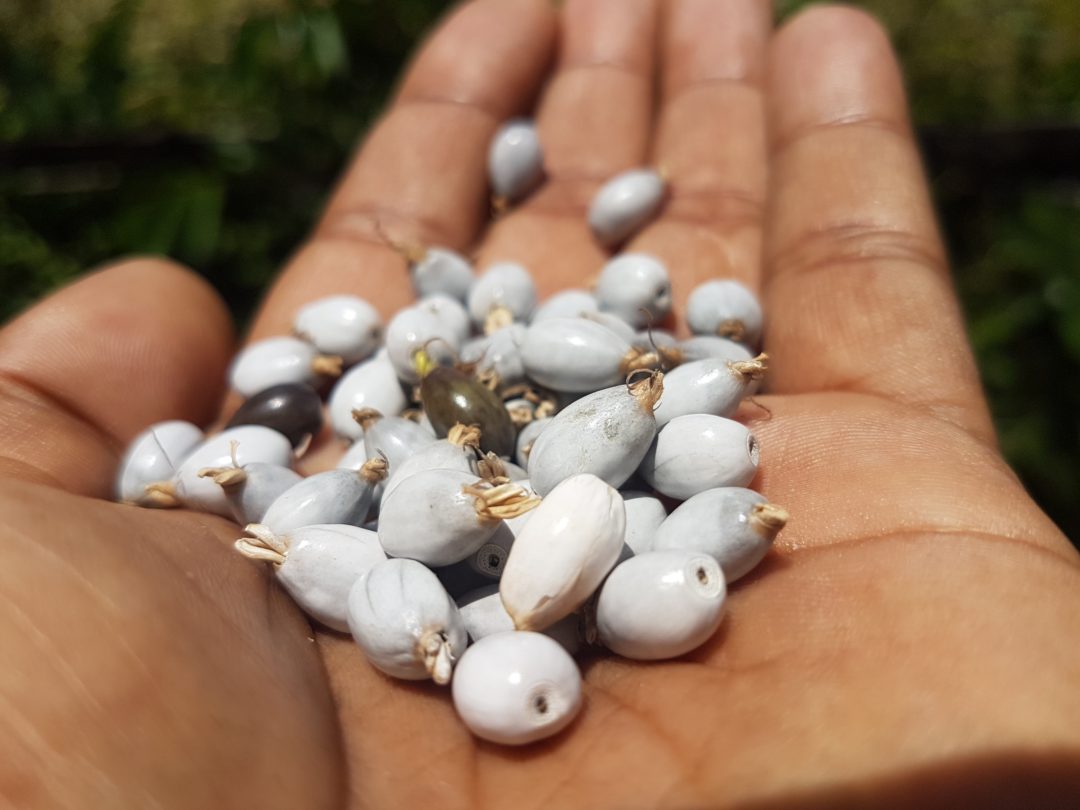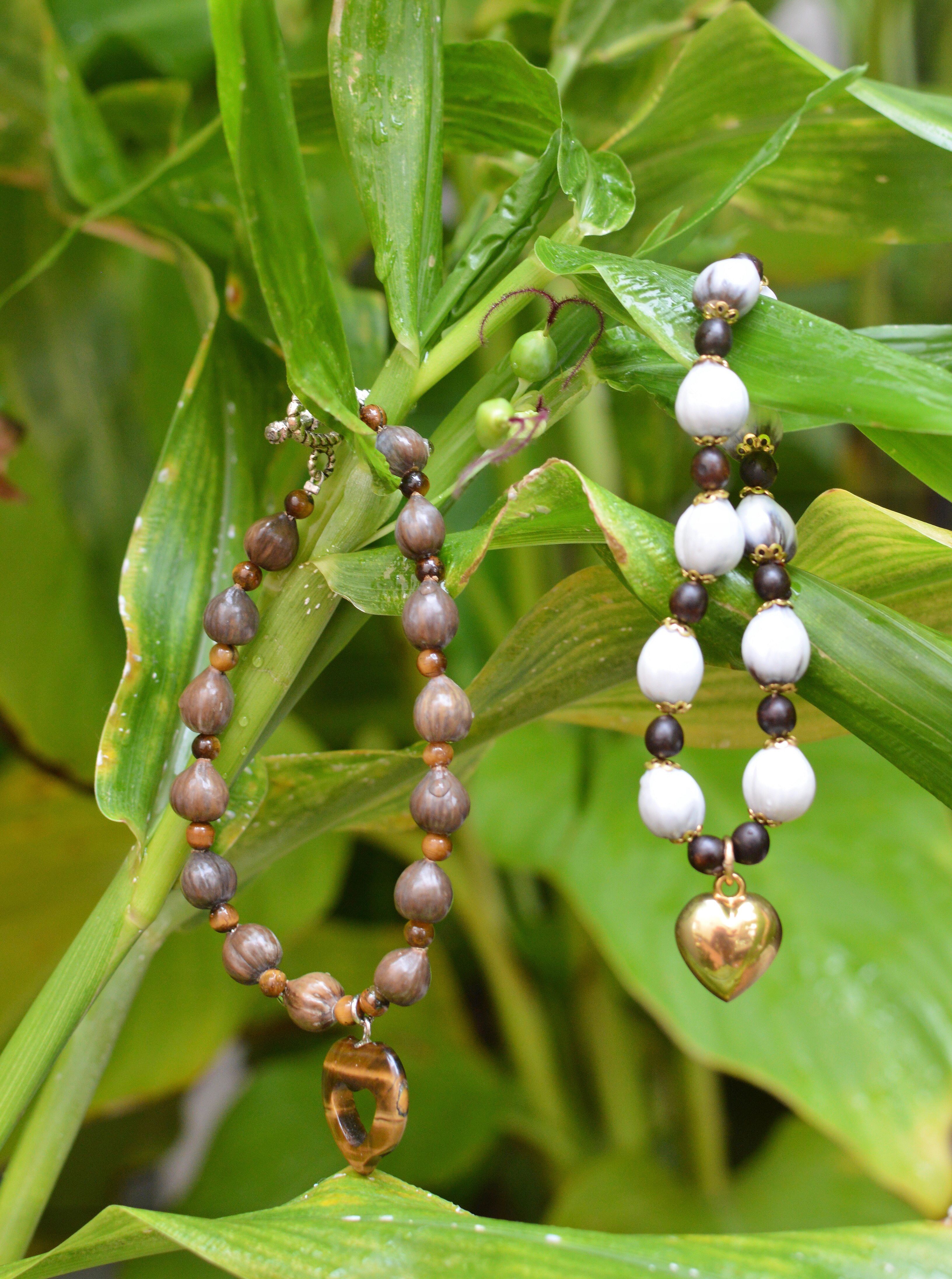Job’s tears (coix lacryma-job’s) aka Ancient Barley is a tall grain bearing perennial tropical plant that is a member of the grass family that is closely related to corn is popular in Asian cultures as a food source and for making jewelry. Job’s tears, also known as Chinese pearl barley, received their name due to the way they look while still in the husk: like fat, shining brown or gray teardrops. It can be seen growing wildly across Guyana and is known locally as BUCK BEADS. And is also used in making jewelry. This unique ancient grain is packed with protein, amino acids, fiber, vitamins and minerals.
Some of its characteristics includes:
- Teardrop shaped
- Hulled and polished to a pearly grayish-white
- Slightly sweet, creamy flavor
- Naturally gluten free

A wild grass that produces nature’s most perfect bead.
There are two main varieties of the species:
- The cultivated variety, which is harvested as a cereal crop, has a soft shell and is used medicinally in parts of Asia.
- The wild variety, which has hard-shelled pseudo-carps which are very hard, pearly white, oval structures, used as beads for making rosaries, necklaces and other objects.
Origin Of Buck Beads
Originally, from India and now are indigenous to South East Asia region like China, Japan, the Philippines, Burma, as well as Thailand. And is now growing wildly throughout the world. In southern India, Buck beads have already been grown for around 4000 years. The seeds are generally present in archaeological sites. The grass is usually growing in rice fields nearby. Archaeologists call the seeds, rice beads.
Description Of Buck Beads
This annual grass is native to south-east Asia and grows to a height of around 3 feet, with knobbly, bamboo-like stems from the bases of which new ‘tillers’ arise, these sometimes self- layering. The glossy deep green leaves are up to 2 inches wide with slightly wavy edges. The flowering and fruiting spikelets are insignificant, but the shiny, pea-sized receptacles that enclose their bases harden in autumn to a pale bluish gray and have often been used for beads and other decorative purposes. Some selected strains are cultivated for their edible grains. Perennial growing to 1m by 0.15m. It is in leaf from May to October, in flower from July to October, and the seeds ripen from September to November. The flowers are monoecious and are pollinated by the wind.
Nutritional Value Of Buck Beads
Like most cereal grains, Buck beads is nutritious, containing essential amino acids, fiber, vitamins and minerals. Compared with medium grain brown rice, it has about the same amount of B-complex vitamins and food energy (360 -380 k.calories) per 100g, but has higher amounts of calcium (435mg vs 268mg) and iron (5.0mg vs 1.8mg), and double the amount of protein (15.4 g vs 7.5g).
7 Healthy Benefits Of Buck Beads
- Allergies – One of the traditional uses for Buck beads is to treat allergies, including topical preparations of plant extracts for an allergic skin condition called contact dermatitis. Research published in the “Journal of Agricultural and Food Chemistry” in June 2003 found that extracts from the plant also suppressed allergic reactions in laboratory mice and boosted their immune systems.
- Cholesterol – Diabetic mice were fed the seeds from Buck beads plants along with a high-cholesterol diet for four weeks in a study published in the “International Journal for Vitamin and Nutrition Research” in September 2006. Compared to a control group, the seed-eating mice had significantly reduced levels of total cholesterol and harmful low-density lipoprotein, or LDL, cholesterol.
- Cancer Prevention and Treatment – Several research teams in China have studied the effects of Buck beads on cancers of the colon, pancreas, lung, liver, breast and also leukemia, with promising results. One study, published in the “Journal of Ethnopharmacology” in September 2008, found extracts of Buck beads significantly inhibited fatty acid synthase activity in the liver. This is important because human cancer cells contain high levels of fatty-acid synthase, a substance linked to aggressive tumor cell growth.
- Endocrine Disorders – Buck beads extracts are used to treat endocrine disorders due to the plant’s ability to decrease hormones like progesterone and testosterone. In the December 2000 issue of the “Journal of Traditional Chinese Medicine,” painful menstrual symptoms were reduced 90 percent, which was a much better result than a control group treated with prescription medications.
- Gastrointestinal Benefits – Buck beads may also have protective benefits for the gastrointestinal system. A June 2011 study in the “Journal of Agricultural and Food Chemistry” found that Buck beads seeds inhibited gastric cancer cells in vitro and were also able to decrease stomach ulcers in mice.
- Osteoporosis – A study published in 2008 in the “Asia Pacific Journal of Clinical Nutrition” found that Buck beads seeds improved levels of several osteoporosis biomarkers in the blood of the mice as compared to a control group. The scientists concluded that the extracts may be capable of reversing osteoporosis in rats and could also be a helpful healthy food for osteoporosis prevention.
- Weight Loss – Obese mice were injected with extracts from Buck beads for four weeks in research published in 2004 in the journal “Life Sciences.” Compared to a control group, the mice fed the extracts had reduced body weights, food intake, fat size, adipose fat tissue mass and levels of cholesterol and triglycerides.
Precaution: There have been few human trials of Buck beads, and side effects are largely unknown. A 2005 study in the “Journal of Toxicology & Environmental Health” found pregnant rats fed Buck beads experienced a higher rate of abortions and the extracts also poisoned the developing embryos. Do not use Buck beads if you are pregnant, and check with your doctor before using extracts from the plant for any health condition.
Some Culinary Uses Of Buck Beads Worldwide
- Before corn (Zea mays) became popular in Southern Asia, Job’s tears was rather widely cultivated as a cereal in India.
- Nutritious soft-shelled seeds are widely consumed in macrobiotic cuisine
- The seed is cooked. A pleasant mild flavor, it can be used in soups and broths
- It can be ground into a flour and used to make bread or used in any of the ways that rice is used.
- The pounded flour is sometimes mixed with water like barley for barley water.
- The pounded kernel is also made into a sweet dish by frying and coating with sugar.
- A tea can be made from the parched seeds, while beers and wines are made from the fermented grain
- A coffee is made from the roasted seed
- In India, the Nagas use the grain for brewing a beer called zhu or dzu.
- Japanese brew a tea and an alcoholic beverage, and roasted seeds are made into a coffee-like drink.
Medicinal Uses Of Buck Beads
- In Chinese medicine, the seeds strengthen the spleen and counteract “damp heat”, and are used for edema, diarrhea, rheumatoid arthritis and difficult urination
- This herb is added to medicinal formulas to regulate fluid retention and counteract inflammation.
- A tea from the boiled seeds is drunk as part of a treatment to cure warts
- The roots have been used in the treatment of menstrual disorders.
Buck Beads
Known locally as BUCK BEADS, it is very nutritious and contains many vitamins and minerals. Can be seen growing wildly across Guyana. It is used to make jewelry and just simply used as decorations. It has many health benefits. It is truly a wild grass that produces nature’s most perfect bead.
Article References:
- https://www.britannica.com/plant/Jobs-tears
- https://davesgarden.com/guides/articles/view/1714
- https://www2.palomar.edu/users/warmstrong/plapr99.htm
- https://myfolia.com/plants/5945-jobs-tears-coix-lacryma
- https://www.livestrong.com/article/510539-the-health-benefits-of-jobs-tears/
- https://www.yourhealthremedy.com/medicinal-plants/jobs-tears-coix-seed-nutritional-facts-health-benefits/
- https://woodlandfoods.com/products/job%27s-tears/c-23/p-12803?cat=103
- https://www.herbalpedia.com/blog/?p=65








1 Comment
Pingback: Ancient Red Adornment Known Falsely as ‘Buck Beads’ or ‘Jumbie Beads’ – Things Guyana